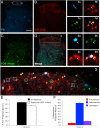Pain and itch processing by subpopulations of molecularly diverse spinal and trigeminal projection neurons
- PMID: 34234018
- PMCID: PMC8285968
- DOI: 10.1073/pnas.2105732118
Pain and itch processing by subpopulations of molecularly diverse spinal and trigeminal projection neurons
Abstract
A remarkable molecular and functional heterogeneity of the primary sensory neurons and dorsal horn interneurons transmits pain- and or itch-relevant information, but the molecular signature of the projection neurons that convey the messages to the brain is unclear. Here, using retro-TRAP (translating ribosome affinity purification) and RNA sequencing, we reveal extensive molecular diversity of spino- and trigeminoparabrachial projection neurons. Among the many genes identified, we highlight distinct subsets of Cck+ -, Nptx2+ -, Nmb+ -, and Crh+ -expressing projection neurons. By combining in situ hybridization of retrogradely labeled neurons with Fos-based assays, we also demonstrate significant functional heterogeneity, including both convergence and segregation of pain- and itch-provoking inputs into molecularly diverse subsets of NK1R- and non-NK1R-expressing projection neurons.
Keywords: RNA-seq; dorsal horn; itch; pain; projection neurons.
Conflict of interest statement
The authors declare no competing interest.
Figures








Similar articles
-
The Neurokinin-1 Receptor is Expressed with Gastrin-Releasing Peptide Receptor in Spinal Interneurons and Modulates Itch.J Neurosci. 2020 Nov 11;40(46):8816-8830. doi: 10.1523/JNEUROSCI.1832-20.2020. Epub 2020 Oct 13. J Neurosci. 2020. PMID: 33051347 Free PMC article.
-
The majority of dorsal spinal cord gastrin releasing peptide is synthesized locally whereas neuromedin B is highly expressed in pain- and itch-sensing somatosensory neurons.Mol Pain. 2012 Jul 9;8:52. doi: 10.1186/1744-8069-8-52. Mol Pain. 2012. PMID: 22776446 Free PMC article.
-
Anatomical evidence of pruriceptive trigeminothalamic and trigeminoparabrachial projection neurons in mice.J Comp Neurol. 2016 Feb 1;524(2):244-56. doi: 10.1002/cne.23839. Epub 2015 Jul 14. J Comp Neurol. 2016. PMID: 26099199 Free PMC article.
-
Modulation of Pain and Itch by Spinal Glia.Neurosci Bull. 2018 Feb;34(1):178-185. doi: 10.1007/s12264-017-0129-y. Epub 2017 Apr 7. Neurosci Bull. 2018. PMID: 28389872 Free PMC article. Review.
-
Spinal Microcircuits and the Regulation of Itch.In: Carstens E, Akiyama T, editors. Itch: Mechanisms and Treatment. Boca Raton (FL): CRC Press/Taylor & Francis; 2014. Chapter 20. In: Carstens E, Akiyama T, editors. Itch: Mechanisms and Treatment. Boca Raton (FL): CRC Press/Taylor & Francis; 2014. Chapter 20. PMID: 24830016 Free Books & Documents. Review.
Cited by
-
The Spino-Parabrachial Pathway for Itch.Front Neural Circuits. 2022 Feb 17;16:805831. doi: 10.3389/fncir.2022.805831. eCollection 2022. Front Neural Circuits. 2022. PMID: 35250493 Free PMC article. Review.
-
Functional and anatomical analyses of active spinal circuits in a mouse model of chronic pain.Pain. 2024 Mar 1;165(3):685-697. doi: 10.1097/j.pain.0000000000003068. Epub 2023 Oct 10. Pain. 2024. PMID: 37820238 Free PMC article.
-
Long-term optical imaging of the spinal cord in awake behaving mice.Nat Methods. 2024 Dec;21(12):2363-2375. doi: 10.1038/s41592-024-02476-3. Epub 2024 Nov 12. Nat Methods. 2024. PMID: 39533007
-
Neural pathways that compel us to scratch an itch.J Biosci. 2024;49:70. J Biosci. 2024. PMID: 38973668 Free PMC article. Review.
-
Piezo2 mechanosensitive ion channel is located to sensory neurons and nonneuronal cells in rat peripheral sensory pathway: implications in pain.Pain. 2021 Nov 1;162(11):2750-2768. doi: 10.1097/j.pain.0000000000002356. Pain. 2021. PMID: 34285153 Free PMC article.
References
Publication types
MeSH terms
Substances
Grants and funding
LinkOut - more resources
Full Text Sources
Medical
Research Materials

